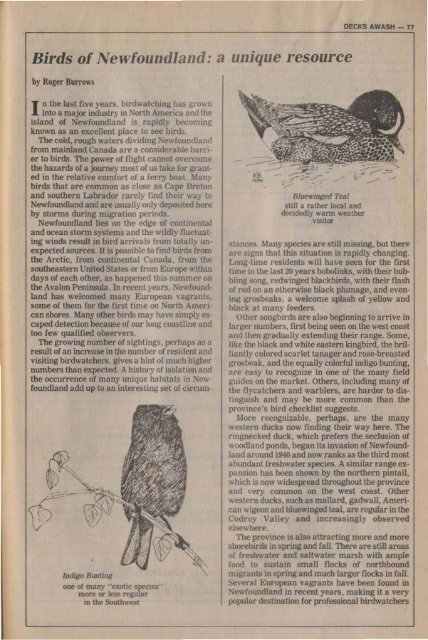Newfoundland - Memorial University's Digital Archives Initiative
Newfoundland - Memorial University's Digital Archives Initiative
Newfoundland - Memorial University's Digital Archives Initiative
You also want an ePaper? Increase the reach of your titles
YUMPU automatically turns print PDFs into web optimized ePapers that Google loves.
DECKS AWASH - 77<br />
Birds of <strong>Newfoundland</strong>: a unique resource<br />
by Roger Burro.....s<br />
I<br />
n the last five yea rs, birdwa tching has grown<br />
into a major industry in North America and the<br />
island of <strong>Newfoundland</strong> is rapidly becoming<br />
known as an excell ent place to see birds.<br />
The cold, rough waters dividing <strong>Newfoundland</strong><br />
from mainland Canada are a considerable barrier<br />
to birds . The power of flight cannot overcome<br />
the hazards of a journey most of us take for granted<br />
in the relative comfort of a ferry boat. Many<br />
birds that ar e common as close as Cape Breton<br />
and southern Labrador rarely find their way to<br />
<strong>Newfoundland</strong>and are usually only deposited here<br />
by storms during migr ation periods.<br />
<strong>Newfoundland</strong> lies on the edge of continental<br />
and ocean storm syst ems and the wildly fluctuating<br />
winds result in bird arrivals from totally unexpected<br />
sources. It is possible to find birds from<br />
the Arctic , from continental Canada. from the<br />
southeastern United States or from Europe within<br />
days of each other , as hap pened this summer on<br />
the Avalon Peninsula . In recent years, <strong>Newfoundland</strong><br />
has welcomed many European vagrants,<br />
some of them for the first time on Nort h Amer i<br />
can shores. Many other birds may have simply escaped<br />
detection because of our long coastline and<br />
too few qualified observ ers.<br />
The growing number of sightings, perhaps as a<br />
result of an increase in the number of resident and<br />
visiting birdwatchers, gives a hint of much higher<br />
numbers than expected . A history of isolation and<br />
the occurrence of many unique hab itats in <strong>Newfoundland</strong><br />
add up to an inter esting set of circ um-<br />
Indigo Bunung<br />
one of many "exotic species"<br />
more or less regula r<br />
in the Southwest<br />
BJuewinged Teal<br />
still a rath er local and<br />
decidedly warm weather<br />
visitor<br />
stances. Many species ar e still missing, but there<br />
are signs tha t this situation is rapidly changing .<br />
Long-time residents will have seen for the first<br />
time in the last 20years bobolinks, with their bubbling<br />
song, red winged blackbirds, with their flash<br />
of red on an otherwise black plumage, and evening<br />
grosbeaks, a welcome splash of yellow and<br />
black at many feeders .<br />
Other songbirds are also beginning to arrive in<br />
larger numbers, first being seen on the west coast<br />
and then gradually extending their range. Some,<br />
like the black and white eastern kingbird , the brillian<br />
tly colored scarlet tanager and rose-breasted<br />
grosbeak, and the equally colorful indigo bunting,<br />
are easy to recognize in one-of the many field<br />
guides on the market. Others , including many of<br />
the flycatch ers and warblers, are harder to distinguish<br />
and may be more common than the<br />
provi nce's bird checklist suggests .<br />
More recognizable, perhaps, are the ma ny<br />
western ducks now finding their way here . The<br />
ringnec ked duck , which prefers the seclusion of<br />
woodland ponds, began its invasion of <strong>Newfoundland</strong><br />
aro und 1940and now ranks as the third most<br />
abundant freshwater species . A similar range expansion<br />
has been shown by the northern pintail ,<br />
which is now widespread throughout the province<br />
and very common on the west coast. Other<br />
western ducks, such as mallard, gadwall , American<br />
wigeon and bluewinged teal, are regular in the<br />
Codroy Vall ey and increasingly observed<br />
elsewhere.<br />
The province is also attracting more and more<br />
shorebirds in spring and fall. There are still areas<br />
of fres hwater and saltwater marsh with ample<br />
food to susta in small flocks of northbound<br />
migrants in spring and much larger flocks in fall.<br />
Severa l European vagrants have been found in<br />
<strong>Newfoundland</strong> in recent yea rs, making it a very<br />
popular destination for professional birdwatchers
















